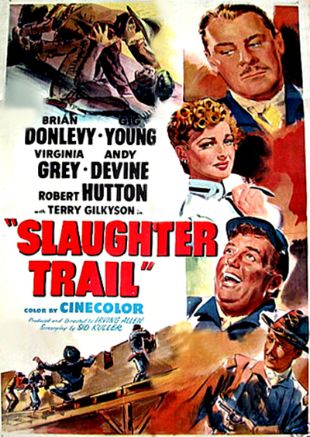One gets the feeling that Irving Allen's Slaughter Trail went through more changes than just the re-casting of a major role -- yes, Brian Donlevy was put into the picture after shooting to replace Howard Da Silva, whose career had ground to a halt over his alleged communist affiliations, but the movie has more of a split personality than that. Large sections of it play almost more like a ballad opera -- and a lighthearted (or, at least, tongue-in-cheek) one at that -- than a traditional western. This is due to the presence of vocalist Terry Gilkyson, whose songs punctuate the action, lightening the mood with a rollicking tone, even around the most serious of scenes, such as the slaughter of a group of unarmed Native Americans. The songs keep coming back into the narrative, but unlike earlier movies that used this device, such as A Walk In The Sun, they're more intrusive in that the lyrics refer not just directly to the action but also to the fact that we're watching a movie; the tone of those lyrics also seem to run counter to what the director (as well as the actors) intended when the scenes were actually shot; it's clear that the actors -- evewn Andy Devine playing a comic relief role, as a rotund United States cavalry sergeant -- were directed "straight" and thought they were making a fully legitimate, serious western. The result is a bizarrely schizophrenic movie that still manages to be fun. even in the version available today, which is another odd detail about Slaughter Trail -- it was shot in Cinecolor (which is referred to in the credits and, if one is not mistaken, the song-narrative also), but at some point in the subsequent 40 years original color elements were lost or destroyed, so that by the time it was released on home video in the early 1990's by Turner Entertainment, it was only available in black-and-white. As a result of this odd history and these strange attributes, the movie is so bizarre a viewing experience on so many levels that it can be recommended on that basis -- approaching the general realm of such cinematic/creative freak shows as Plan 9 From Outer Space, The Creeping Terror, or The Astounding She Monster, if not quite as eye-poppingly inept or strange as they are -- much more so than as a traditional western.

Slaughter Trail (1951)
Directed by Irving Allen
Genres - Western |
Release Date - Oct 11, 1951 (USA - Unknown) |
Run Time - 78 min. |
Countries - United States |
MPAA Rating - NR
Share on